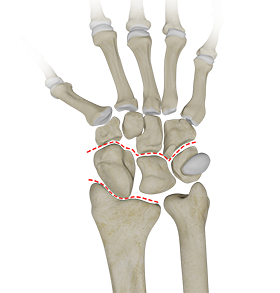
What is Carpal Instability?
Carpal instability is the loss of alignment of the carpal bones and/or radioulnar joint. The wrist is a complex joint that connects the forearm to the hand and allows it to move. It consists of 8 small bones called carpals that articulate with two long bones of the forearm (radius and ulna). The joint is supported by ligaments, tendons, nerves, blood vessels and muscles that help in movement. The 4 types of carpal instability are:
- Carpal Instability Dissociative (CID): Instability occurs only to the carpal bones. Also called intracarpal row instability.
- Carpal Instability Nondissociative (CIND): Misalignment of carpal bones with the radius and ulna. Also known as intercarpal row instability.
- Carpal Instability Combined (CID): Combined misalignment of carpal bones, radius, and ulna.
- Carpal Instability Adaptive (CIA): Conditions outside the wrist can cause carpal instability. For example, congenital disorders like Madelungs deformity can cause CIA or a history of distal radius fracture that healed improperly.
Symptoms of Carpal Instability
Symptoms include:
- Loss of normal alignment of carpal bones
- Changes in the range of motion
- Pain and swelling of the wrist
- Inability to grip objects
- Arthritis and disability (later stages)
What Causes Carpal Instability?
Trauma or a fall on an outstretched arm can injure the wrist ligaments causing carpal instability. Ligaments are tissues that connect bones to other bones. They are made up of several fibers and one or all of the fibers may be involved. Complete ligament injury occurs when all the fibers are torn. Carpal instability can also be caused due to fracture of the wrist bones or degenerative arthritis.
Diagnosis of Carpal Instability
Your doctor will assess your symptoms and take a medical history.
- Physical examination of your wrist will be performed.
- Imaging studies such as X-ray, MRI or CT-scan will be ordered.
- Diagnostic arthroscopy may be required to evaluate the injury to ligaments or bones.
Treatment of Carpal Instability
Conservative treatment options can include:
- Activity modification
- Immobilization using a splint, brace or plaster cast
- Musculotendinous exercises
- Steroid injections for pain
Surgery maty be recommended if you do not respond to conservative treatment options. The type of surgery depends on the extent and number of ligaments injured.
Related Topics
- Wrist Fracture
- Fractures of the Hand and Fingers
- Wrist Sprain
- Flexor Tendon Injuries
- Distal Radioulnar Joint (DRUJ) Arthritis
- Ulnar Nerve Compression in Guyon's Canal
- Scaphoid Facture
- Industrial Hand Trauma
- Distal Radius Osteotomy to Correct Mal-Union (Crooked Painful Wrist)
- Distal Intersection Syndrome
- Distal Biceps Avulsion
- Adult Forearm Fractures
- Arthritis of the Hand and Wrist
- Arthritis of the Thumb
- Ganglion Cyst
- Boutonniere Deformity
- Carpal Tunnel Syndrome
- De Quervain's Tendinosis
- Dupuytren's Contracture
- Hand Pain
- Hand Infections
- Trapeziometacarpal (TMC) Arthritis
- Wrist Injuries
- Wrist Tumors
- Boxer's Fracture
- Swan Neck Deformity
- Carpal Instability
- Bennett's Fracture
- Kienbock's Disease
- Scapholunate Dissociation
- Triscaphoid Joint Arthritis
- Ulnar Carpal Impaction
- Triangular Fibrocartilage Complex Injury (TFCC)
- Guyon's Canal Syndrome
- Hand Masses
- Distal Radioulnar Joint (DRUJ) Instability
- Work Related Hand Injuries
- Wrist Ligament Tear and Instability
- Metacarpophalangeal Joint Arthritis





